Vintage Voice of Music Record Players
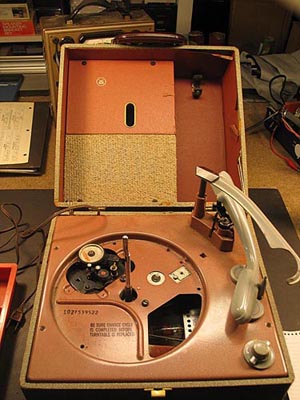 1954 Voice of Music Model 990 Tri-O-Matic Record Player
1954 Voice of Music Model 990 Tri-O-Matic Record Player
I found this player at a flea market for $20. It was in fairly good condition, except someone had tried to force the lid closed with the record support arm over the spindle. This bent the record support arm and knocked the tonearm loose, along with some cosmetic damage inside the player, including bending the motor board.
I first recapped the amplifier, but couldn't get it to work. It turned out I had misread values on a cap and a resistor. With those errors corrected, the amp plays quite nicely now.
The next step was to straighten out the motor board, which I did with clamps and some hardwood blocks:
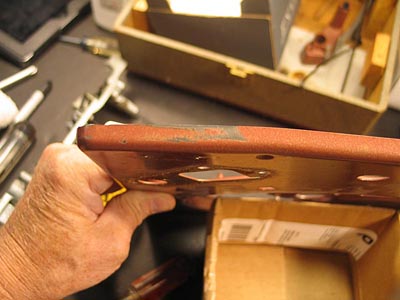
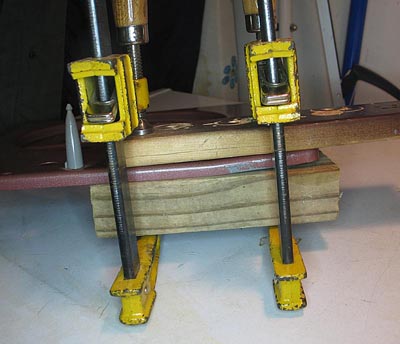
To straighten the bent record support arm, I removed the small plastic trim piece. I drilled a hole the same size as the support arm shaft in a block of wood. I then used a body hammer to restore the support arm and shaft to a 90 degree angle. Doing this loosened the shaft where it is secured to the support arm, so I used J-B weld under arm to repair that.
Next, I cleaned and lubed the motor. The changer is a 952-2 model. I completely disassembled the slide mechanism, cleaned it, added lubrication as per Gary Stork's lubrication guide, and re-assembled everything. However, I had a problem. The motor would bog down and stall as soon as the record dropped. If I removed the ejector bracket, then everything cycled properly, except a record wouldn't drop of course. I tried putting a weaker spring in the spindle, but that made things worse.
I contacted Gary at Voice of Music, thinking I might need another spindle, but he said to soak the spindle in a solvent and then work it, soak, and work it. So I soaked it in a can of carburetor cleaner for three days, worked it, and when I re-installed the spindle in the unit, everything worked as it should. A few weeks after I finished this project, I ran across an identical unit that had an almost mint cabinet, but was missing the amplifier. I bought the cabinet and transfered the mechanics from my $20 unit to the new cabinet, which is the one shown at right, below, and in the video, which can be seen on You Tube here
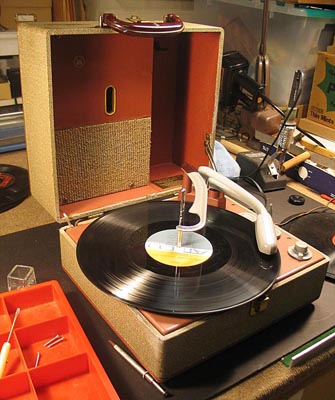

1957 Zenith Cobramatic Model S-14084
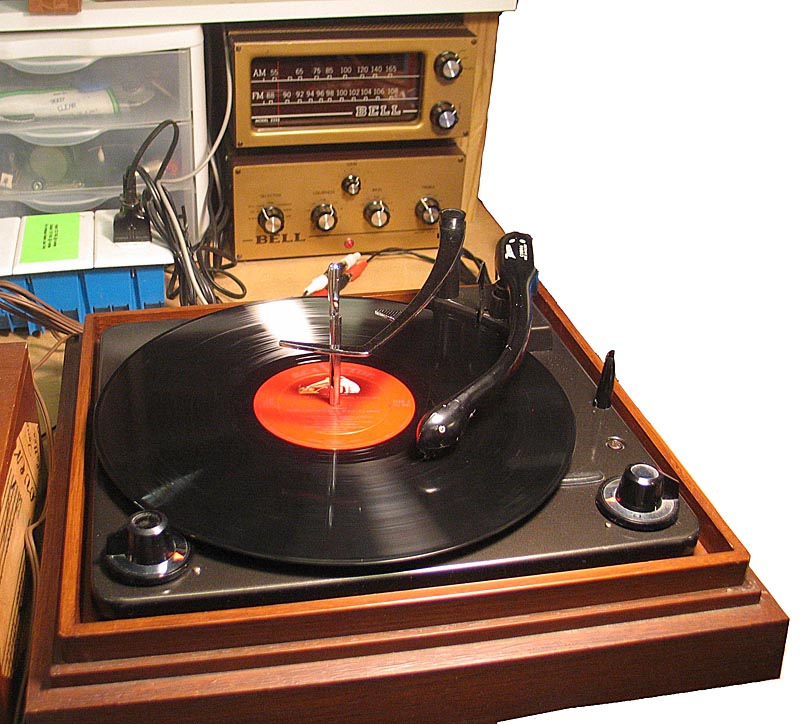 This 1957 Zenith Cobramatic Model S-14084 record changer is actually a Voice of Music Model 1210A-71 built for Zenith. The distinctive chrome ring and Cobramatic tone arm set it apart from most V-M products. Voice of Music provided changers for many house brands over their years in business. This changer came from a Zenith console the owner was planning to repurpose.
This 1957 Zenith Cobramatic Model S-14084 record changer is actually a Voice of Music Model 1210A-71 built for Zenith. The distinctive chrome ring and Cobramatic tone arm set it apart from most V-M products. Voice of Music provided changers for many house brands over their years in business. This changer came from a Zenith console the owner was planning to repurpose.
The first step was to obtain a service manual for the changer. I was able to find the Zenith service manual on eBay, and also got a copy of the V-M service manual for the changer from Gary Stork at Voice of Music Audio Enthusiasts, along with a Basic Record Changer Restoration and Lubrication Guide. Gary also provided the new idler wheel, motor, cartridge and stylus, along with some other miscellenous parts, and good advice on the restoration.
I began restoration in February, 2012, with intentions of completing it within a few days. It ended up taking three years. After taking the machine apart, something came up, and I didn't get back to it until August, 2015. Luckily, when I disassembled the changer, I carefully marked every piece and took numerous photographs. In the meantime, I had restored two other V-M changers, so the Cobramatic turned out to be fairly easy to get back together.
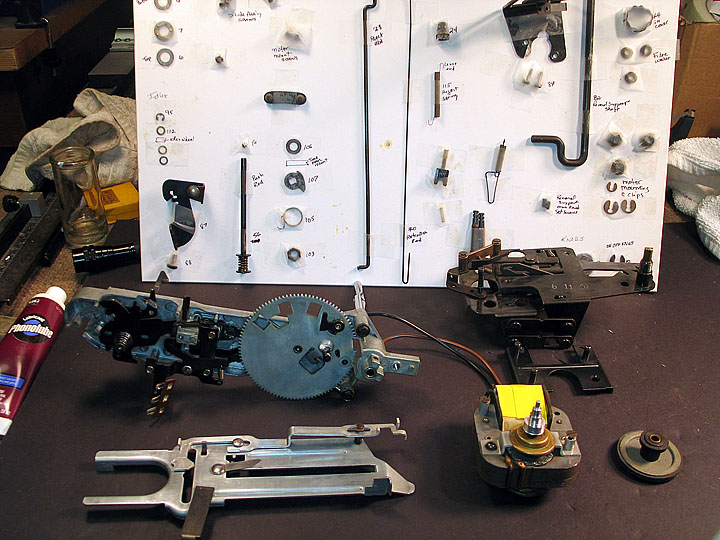 The changer deck was dull and I could not get it to clean up very well, so I decided to repaint it. I used Rustoleum Metallic Carbon Mist, and it turned out beautifully. The chrome ring cleaned up nicely as well.
The changer deck was dull and I could not get it to clean up very well, so I decided to repaint it. I used Rustoleum Metallic Carbon Mist, and it turned out beautifully. The chrome ring cleaned up nicely as well.
All of the parts in the slide and cycling mechanism were taken apart and cleaned with alcohol or contact cleaner to remove all the old, dried grease. Phonolube was applied as per the Lubrication Guide from Voice of Music. The tone arm was disassembled and rebuilt. The original cartridge was a Tetrad monophonic cartridge. I initially installed a Pfanstiehl MG55C cartridge, but changed it for a Pfanstiehl P228-DS73 as I wanted to be able to play 78 records as well as LP's and 45's.
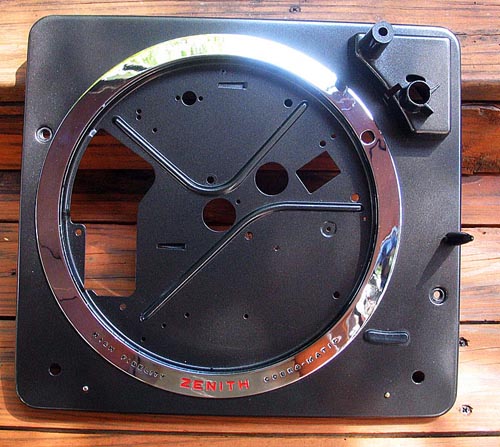 The motor turned out to have a frozen upper bearing, so I obtained a replacement motor from V-M, and a new idler wheel. After re-assembly, there was still a problem with the motor assembly not working properly, so I pulled the motor assembly from the V-M model 1241 discussed below, and installed it in the Cobramatic, and it worked perfectly. I later obtained a new idler arm spring and put the other motor back in the model 1241, where it worked fine.
The motor turned out to have a frozen upper bearing, so I obtained a replacement motor from V-M, and a new idler wheel. After re-assembly, there was still a problem with the motor assembly not working properly, so I pulled the motor assembly from the V-M model 1241 discussed below, and installed it in the Cobramatic, and it worked perfectly. I later obtained a new idler arm spring and put the other motor back in the model 1241, where it worked fine.
 Since the Cobramtic had originally come from a console, I had to rewire it for stand-along operation, installing an AC line cord and a pair of RCA phono plugs for the cartridge pickup. I mounted the Cobramatic in a V-M base. It also has the 45 adapter for playing 45's, which it does flawlessly.
Since the Cobramtic had originally come from a console, I had to rewire it for stand-along operation, installing an AC line cord and a pair of RCA phono plugs for the cartridge pickup. I mounted the Cobramatic in a V-M base. It also has the 45 adapter for playing 45's, which it does flawlessly.
Click here to hear the Zenith Cobramatic play on You Tube
ca 1962 Voice of Music Model 1241
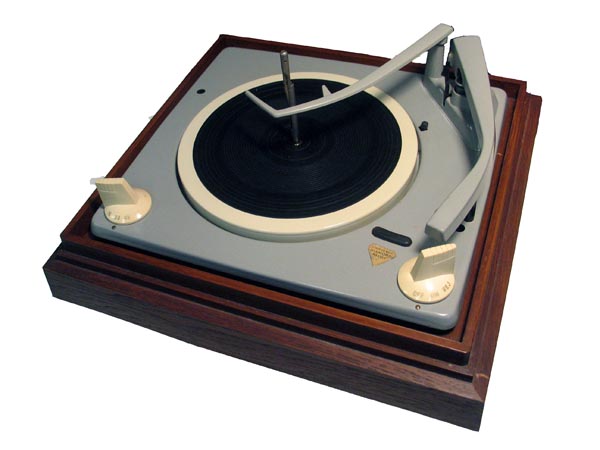 I originally bought this record changer to install in the 1954 Magnavox Console described in the section on Audio & Hi-Fi Equipment, but ended up installing a Magnavox Collaro instead. After working on the VM 950 changer described in the next section, I decided to go ahead and restore the 1241. The changer actually was working, but poorly, due to dried lubrication and crud, so I did a complete teardown, cleaning, and lubrication. It now works very well mechanically.
I originally bought this record changer to install in the 1954 Magnavox Console described in the section on Audio & Hi-Fi Equipment, but ended up installing a Magnavox Collaro instead. After working on the VM 950 changer described in the next section, I decided to go ahead and restore the 1241. The changer actually was working, but poorly, due to dried lubrication and crud, so I did a complete teardown, cleaning, and lubrication. It now works very well mechanically.
 The idler wheel was in pretty good shape, as were the motor mount grommets, so I did not replace them. I used a service manual and a restoration and lubrication guide I purchased from Gary Stork at the Voice of Music. Gary has parts and service documentation for most VM products as well as RCA and other popular brands.
The idler wheel was in pretty good shape, as were the motor mount grommets, so I did not replace them. I used a service manual and a restoration and lubrication guide I purchased from Gary Stork at the Voice of Music. Gary has parts and service documentation for most VM products as well as RCA and other popular brands.
It came with a Sonotone 16T cartridge and stylus installed, but the stylus is shot. I have ordered a replacement. It is sitting in a VM base unit I purchased from Gary at Voice of Music.
1954 Crosley Radio/Record Player Combo
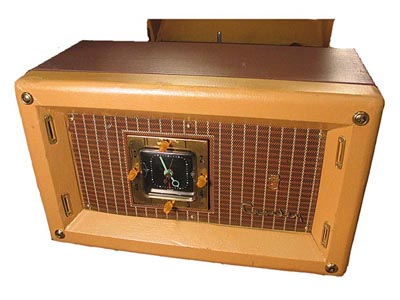
I picked up a somewhat unusual 1954 Crosley Model F-120-BN Radio/Phonograph a couple weeks ago at an antique shop. I bought it because it had a pretty nice looking Voice of Music 950 record changer in it, and, unusual for a machine of this type, a clock on the front. I recapped the chassis, and replaced a bad 12AT6 tube. The other tubes in the lineup were 35W4, 12BA6, 12BE6, and a 50C5 output tube.

The clock was made by Sessions, not Telechron or GE, although it looks similar from the front, but has a very different motor type. The clock ran quietly and accurately, so I just blew out the dust and applied a few drops of oil at key pivot points.
The V-M turntable looked to be in pretty good condition. It was very clean underneath, and the idler wheel and turrets seemed to be in pretty good shape as well. The motor mount grommets were completely missing, though. I ordered a new set from the Voice of Music. Larry Hillis' RCA Model SHF-8 record player restoration thread on the Antique Radio Forum was very helpful as I worked on the turntable. I used Phonolube to grease key sliding surfaces, using Larry's pictures as a guide.
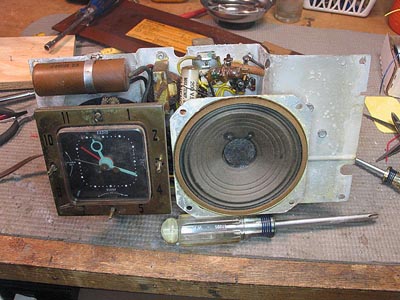
The original Shure P77V cartridge and stylus was DOA, so I replaced it with a Pfanstiehl P228 DS73, also from Voice of Music. The Pfanstiehl has its own lever for switching from LP to 78, but the original lever at the front of the tone arm head can't be removed as it holds the cartridge mount steady.
The cabinet was not in real good shape. There were a number of dents and gouges, and the leatherette covering was worn and fraying at most corners, and had many splits and cracks. I used Plastic Wood to fill the dents and gouges and to stabilize the corners.
I found a product online by Meltonian for recoloring shoes that is basically a spray dye or paint for vinyl, plastic, and leather. It worked very well on the leatherette covering.
The radio plays well, with decent, but not great sensitivity. With the tiny 4" speaker, audio isn't great, but it is a lot better than I thought it would sound. The V-M changer is working, but the motor doesn't always shut off at the end of a cycle after the last record has played, and when playing 78's, it will sometimes stall mid-cycle and I have to nudge the speed control back to 78, then it completes the cycle. It should improve as it is played more, and the lubricants get distributed better. I don't have a 45 adapter, so I haven't tested it with 45's.
For a more detailed description of the restoration, and to see and hear it play, visit You Tube at this link: Crosley Radio/Record Player
Back to Record Player & Audio Menu





 1954 Voice of Music Model 990 Tri-O-Matic Record Player
1954 Voice of Music Model 990 Tri-O-Matic Record Player

 This 1957 Zenith Cobramatic Model S-14084 record changer is actually a Voice of Music Model 1210A-71 built for Zenith. The distinctive chrome ring and Cobramatic tone arm set it apart from most V-M products. Voice of Music provided changers for many house brands over their years in business. This changer came from a Zenith console the owner was planning to repurpose.
This 1957 Zenith Cobramatic Model S-14084 record changer is actually a Voice of Music Model 1210A-71 built for Zenith. The distinctive chrome ring and Cobramatic tone arm set it apart from most V-M products. Voice of Music provided changers for many house brands over their years in business. This changer came from a Zenith console the owner was planning to repurpose. The changer deck was dull and I could not get it to clean up very well, so I decided to repaint it. I used Rustoleum Metallic Carbon Mist, and it turned out beautifully. The chrome ring cleaned up nicely as well.
The changer deck was dull and I could not get it to clean up very well, so I decided to repaint it. I used Rustoleum Metallic Carbon Mist, and it turned out beautifully. The chrome ring cleaned up nicely as well. The motor turned out to have a frozen upper bearing, so I obtained a replacement motor from V-M, and a new idler wheel. After re-assembly, there was still a problem with the motor assembly not working properly, so I pulled the motor assembly from the V-M model 1241 discussed below, and installed it in the Cobramatic, and it worked perfectly. I later obtained a new idler arm spring and put the other motor back in the model 1241, where it worked fine.
The motor turned out to have a frozen upper bearing, so I obtained a replacement motor from V-M, and a new idler wheel. After re-assembly, there was still a problem with the motor assembly not working properly, so I pulled the motor assembly from the V-M model 1241 discussed below, and installed it in the Cobramatic, and it worked perfectly. I later obtained a new idler arm spring and put the other motor back in the model 1241, where it worked fine. Since the Cobramtic had originally come from a console, I had to rewire it for stand-along operation, installing an AC line cord and a pair of RCA phono plugs for the cartridge pickup. I mounted the Cobramatic in a V-M base. It also has the 45 adapter for playing 45's, which it does flawlessly.
Since the Cobramtic had originally come from a console, I had to rewire it for stand-along operation, installing an AC line cord and a pair of RCA phono plugs for the cartridge pickup. I mounted the Cobramatic in a V-M base. It also has the 45 adapter for playing 45's, which it does flawlessly. I originally bought this record changer to install in the 1954 Magnavox Console described in the section on Audio & Hi-Fi Equipment, but ended up installing a Magnavox Collaro instead. After working on the VM 950 changer described in the next section, I decided to go ahead and restore the 1241. The changer actually was working, but poorly, due to dried lubrication and crud, so I did a complete teardown, cleaning, and lubrication. It now works very well mechanically.
I originally bought this record changer to install in the 1954 Magnavox Console described in the section on Audio & Hi-Fi Equipment, but ended up installing a Magnavox Collaro instead. After working on the VM 950 changer described in the next section, I decided to go ahead and restore the 1241. The changer actually was working, but poorly, due to dried lubrication and crud, so I did a complete teardown, cleaning, and lubrication. It now works very well mechanically. The idler wheel was in pretty good shape, as were the motor mount grommets, so I did not replace them. I used a service manual and a restoration and lubrication guide I purchased from Gary Stork at
The idler wheel was in pretty good shape, as were the motor mount grommets, so I did not replace them. I used a service manual and a restoration and lubrication guide I purchased from Gary Stork at 

